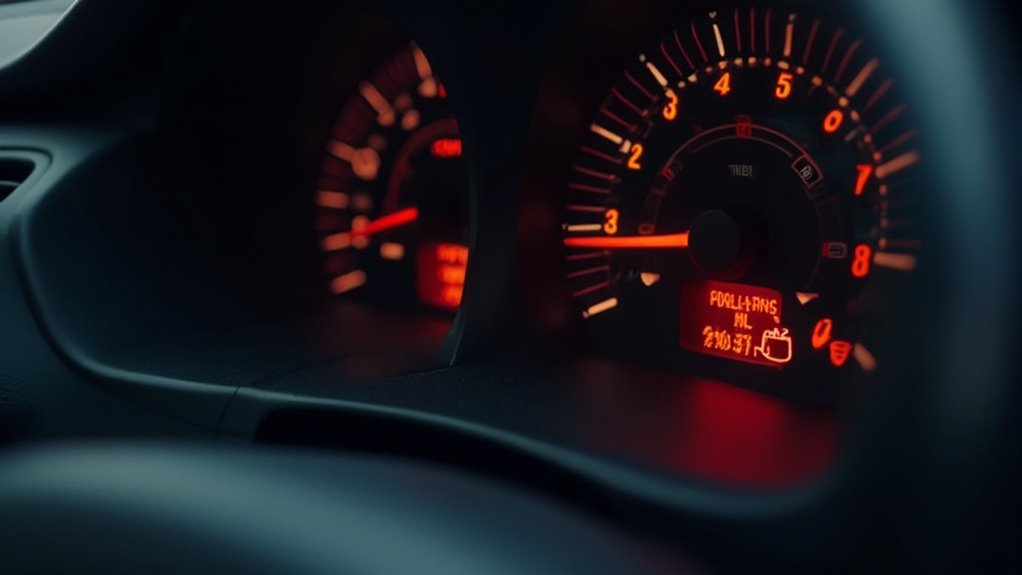The "Check Fuel Fill Inlet" warning means there's a potential issue with your vehicle's evaporative emissions control system, often tied to problems with the gas cap. This could be a loose or damaged cap, or dirt affecting its seal. It's essential to check the cap and its area for any issues. Addressing this warning promptly can prevent more significant problems. Stick around to find out how to fix these issues and what repairs might cost.
Understanding the "Check Fuel Fill Inlet" Warning
When you see the "Check Fuel Fill Inlet" warning on your dashboard, it usually means there's a problem with the evaporative emissions control system (EVAP).
This system plays an essential role in preventing gas vapors from escaping your fuel tank, ensuring both efficiency and environmental safety. It's been a mandatory feature for gasoline-powered vehicles since the 1970s.
The EVAP system consists of various interconnected components that work together to maintain fuel integrity.
Common Causes of the Warning
If you see the "Check Fuel Fill Inlet" warning, it's often due to issues with your fuel cap or the EVAP system.
A loose or missing fuel cap can easily trigger this alert, as can an over-tightened cap that damages the seal. Dirt contamination may also prevent the cap from sealing properly.
Additionally, leaks in the EVAP system can cause both this warning and the "Check Fuel Cap" message.
Keeping an eye on these components will help you avoid more significant problems down the road. Addressing these issues promptly can save you time and money in the long run.
How to Fix Fuel Fill Inlet Issues
Addressing the "Check Fuel Fill Inlet" warning involves inspecting and fixing the components related to your vehicle's fuel system.
Start by checking the gas cap; verify it's properly tightened and free of dirt. For vehicles with capless gas tanks, clean and lubricate the gas tank flap to guarantee it opens and closes smoothly.
Inspect the flap carefully with a tool to prevent dropping items inside. Regular maintenance of the flap and sealing area is essential to avoid future issues.
If the problem persists, consider consulting a professional to diagnose any underlying EVAP system leaks or other complications.
Repair Costs Associated With the Warning
Repair costs associated with the "Check Fuel Fill Inlet" warning can vary greatly, depending on the underlying issue.
Here's a quick breakdown of potential costs you might encounter:
- Loose or dirty gas cap: $5 to $20
- Capless fuel system cleaning: $50 to $100
- Vacuum leak diagnosis: $100 to $300
- Full EVAP system repairs: $500 to $1,000+
Addressing minor issues early can save you from more expensive repairs later.
It's always a good idea to get a professional diagnosis to determine the exact cause and associated costs.
Safety Considerations When Driving With the Warning
While the "Check Fuel Fill Inlet" warning can be concerning, driving with this alert is generally safe as long as you monitor your vehicle's performance.
Keep an eye on your engine's behavior; if you notice unusual sounds, decreased power, or poor fuel efficiency, it's time to pull over. Avoid high speeds and heavy acceleration, as these can exacerbate any underlying issues.
Verify your gas cap is secure before heading out. Addressing the warning promptly is vital, as neglecting it could lead to more significant problems down the road.
Stay vigilant, and you'll maintain a safer driving experience.
Related Vehicle Maintenance Practices
Monitoring your vehicle's performance after seeing the "Check Fuel Fill Inlet" warning can help prevent more serious issues, but regular maintenance practices are also key to keeping your car running smoothly.
Here are some essential practices to take into account:
- Fuel Induction Service: Clean injectors and valves every 30,000 to 50,000 miles.
- Odometer Checks: Verify it's functioning accurately for service intervals.
- Gas Gauge Inspection: Diagnose issues with faulty sending units or wiring.
- EVAP System Maintenance: Regularly check for codes and leaks to maintain efficiency.
Diagnosing EVAP System Problems
When you encounter the "Check Fuel Fill Inlet" warning, it's important to diagnose potential issues within the EVAP system.
Start by checking the fuel cap; verify it's secure and not damaged. If the cap's fine, inspect for leaks in hoses and connections.
Using a diagnostic tool, look for EVAP system codes like P0440 or P0456, which indicate specific problems.
Pay attention to any symptoms, like poor fuel economy or rough idling, as they can guide your troubleshooting.
If you're unsure, it might be best to consult a professional to avoid further complications.
Frequently Asked Questions
Can I Drive My Car With the Warning Active?
Yes, you can drive your car with the warning active, but it's best to check the issue soon. Ignoring it might lead to more significant problems down the road, so don't delay addressing it.
How Can I Reset the "Check Fuel Fill Inlet" Warning?
To reset the "Check Fuel Fill Inlet" warning, you can try disconnecting the battery for a few minutes. Alternatively, driving the vehicle for a short distance might also clear the warning if the issue's resolved.
Will This Warning Affect My Vehicle's Fuel Economy?
Yes, that warning can affect your vehicle's fuel economy. If the EVAP system isn't functioning properly, it may lead to increased fuel vapor loss, causing your engine to work harder and consume more fuel.
Is There a Specific Fuel Type That Triggers This Warning?
No specific fuel type triggers the "Check Fuel Fill Inlet" warning. It's more about the vehicle's emissions system, particularly related to the fuel cap and EVAP components, rather than the fuel itself you use.
How Often Should I Check My Gas Cap for Issues?
You should check your gas cap regularly, ideally every time you refuel. Ensuring it's secure can prevent pressure issues and potential warnings, keeping your vehicle's evaporative emissions system functioning properly and efficiently.
